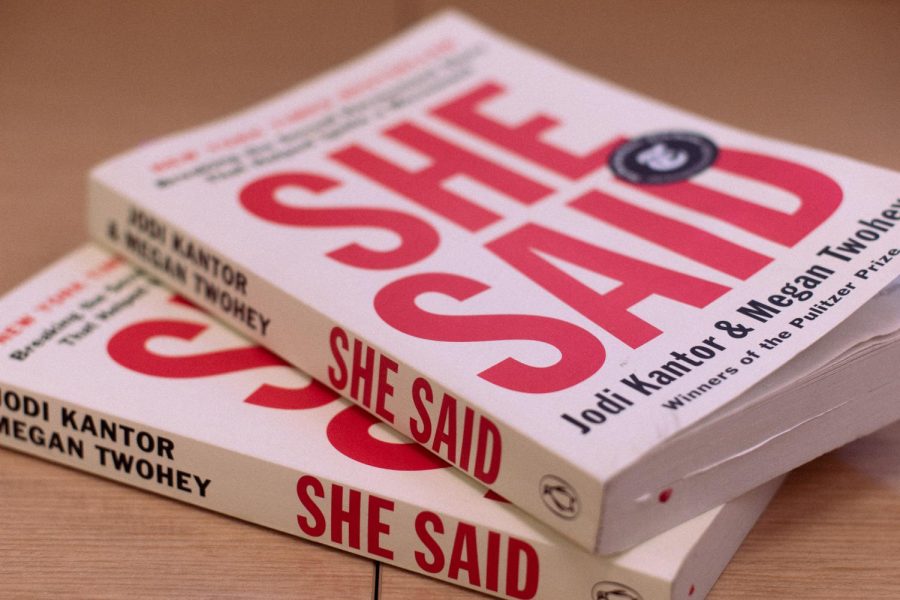“She Said”: How Jodi Kantor and Megan Twohey Used Powerful Journalism To Set the Stage for #MeToo
Journalists Jodi Kantor and Megan Twohey were awarded the Pulitzer Prize in 2018 for the work they published that uncovered former producer Harvey Weinstein’s crimes.
February 2, 2022
At 2:05 p.m. on Oct. 5, 2017, Harvey Weinstein’s world stopped.
It was the moment that Jodi Kantor and Megan Twohey published the groundbreaking article, “Harvey Weinstein Paid Off Sexual Harassment Accusers For Decades,” after months of investigative journalism.
After a long period of communication with Weinstein’s accusers, multiple lawyers, Weinstein’s accountant, top executives at The Weinstein Company, and Harvey Weinstein himself, Kantor and Twohey had unveiled the truth about the famed former producer’s mistreatment of women to the public.
A few years after the story broke, Kantor and Twohey published their book, “She Said: Breaking the Sexual Harassment Story That Helped Ignite a Movement.” The book contains interviews that were previously off the record, providing extra context and information about the story and effectively communicating the fragility of investigative journalism.
The book reads like a captivating novel, following each conversation the journalists had. The reader gets to experience Kantor and Twohey’s thought processes in real-time.
They outline their process in chronological order, starting with reaching out to Rose McGowan after she publicly accused an unnamed producer of sexual harassment via Twitter. McGowan is outspoken and has fought for gender equality in the entertainment industry in the past.
When Kantor reached out to McGowan, she refused to talk — even if the conversation was off the record. Kantor and Twohey stated in the book, “If McGowan, as much an activist as an actress, would not have one off-the-record conversation, who would?”
Kantor and Twohey immediately ran into their first setback — much like McGowan, most sources were unwilling, or unable, to talk. Their first strategy was to convince multiple sources to go public at the same time; “safety in numbers,” they called it. This strategy would prove to be impossible, as Weinstein’s victims were kept silent out of fear of legal action from Weinstein or the worry of publicly sharing private, trauma-inducing stories.
Rebecca Corbett, a New York Times editor, helped Kantor and Twohey think through how they could back up the stories they were hearing by including concrete evidence, with not only accounts from alleged victims but also official documents to serve as proof.
Corbett mostly operated in the background and was not named in the story’s byline. However, she was an important leader of the Weinstein investigation. “People would say that two women had broken the Weinstein story, but it had really been three,” Kantor and Twohey said.
The journalists knew what to search for — settlements. A few months prior to the start of the Weinstein investigation, New York Times reporter Emily Steel broke the story of Bill O’Reilly entering multi-million dollar settlements with women who accused him of sexual harassment. “O’Reilly and Fox had relied on settlements that imposed confidentiality clauses — essentially paying victims to keep quiet,” Kantor and Twohey said.
It was entirely possible that Weinstein had entered similar agreements with people who had spoken up about Weinstein’s wrongdoings. However, the journalists had no idea how many settlements containing these confidentiality clauses Weinstein had entered.
Perhaps the most essential part of this story was the relationship between Weinstein, his accusers, and their lawyers. For Weinstein, it was in his best interest to enter a settlement in order to silence his accusers and preserve his public image. Settlements like these were also in the best interest of the lawyers because if their clients entered a large settlement, it meant that they would receive a big paycheck, bigger than what they would receive for taking the case to court and losing.
This scenario left the victims essentially alone. Their lawyers advised them to take settlements to retain privacy, obtain money, and leave the whole ordeal in the past. For Weinstein’s accusers, a settlement would seem like the only way out.
During their investigation, Lanny Davis, one of Weinstein’s many lawyers, revealed to Twohey that Weinstein had been involved in about 8-12 settlements with women. Twohey asked Davis, “Do you think that’s normal for men to make so many payoffs?”
“‘I do,’ he had replied, in a matter-of-fact tone,” the reporters said in their book. His response to the question foreshadowed the movement that would follow once Kantor and Twohey’s article was published.
Even without being legally bound by settlements, other Weinstein accusers were very reluctant to go on the record against the powerful producer. Only days before the article’s publication and after months of communication did the reporters receive confirmation that actress Ashley Judd would agree to go on the record. Judd was the first woman willing to speak out in the story.
When Kantor and Twohey describe this moment in their book, it showed how much they truly cared about getting this information out to the public. When Kantor received confirmation from Judd over the phone, she “lost it, like a marathoner collapsing at the finish line,” Kantor and Twohey said. “She and Megan had spent months living in a state of suspense and responsibility. They would land the story or they would not. Weeping, Jodi searched for something to say to Judd that was equal to the moment but still professional. The best she could muster was: ‘This means the world to me as a journalist.’”
Now that they had a source on the record, time was of the essence. The team continued drafting into the nighttime and eventually went home, but Corbett refused. “That night, she sat and worked away, slowly making the words in the story tighter, clearer, and stronger,” Kantor and Twohey said. “Sometime before dawn, she fell asleep at her desk for 45 minutes. When she woke, she worked some more.”
The amount of courage and resilience that Kantor, Twohey, and Corbett showed throughout the process of investigating Weinstein is inspiring. Everything they said to the interviewees, sent in an email, or wrote down in the story’s draft had to be meticulously thought out.
The journalists and all of the women who shared their stories successfully stood their ground against one of the most powerful men in the entertainment industry and opened the floodgates for the #MeToo movement that followed the article’s publication.
It is easy to look at a well-written article and not put much thought into the amount of time and hard work that went into the piece behind the scenes, but while reading “She Said,” it is impossible to ignore the journalist’s talent and diligence. From being only an observer to their investigation, I gained many valuable takeaways that I will use in the stories I write in the future. I aspire to be as professional, passionate, and intelligent as all of the contributors to the Weinstein story.
The world was changing rapidly at the height of the movement. Companies were taking notice of The Weinstein Company’s downfall and put zero-tolerance policies in place. More women were speaking out against their abusers than ever before.
However, Kantor and Twohey do not ignore the problems with the #MeToo movement in their book. They understood the heavy scrutiny that people who go public with allegations endure, so they took the necessary actions in order to be one step ahead of the critics, protecting their sources. Although Kantor and Twohey understand the vital importance of believing women, “the obligation of journalists was to scrutinize, verify, check, and question information.”
In “She Said” the reporters state, “Though many publications continued to publish exposès based on in-depth investigation and on the record evidence, others were running stories that relied on a single source or unnamed accusers, much lower standards.” Unfortunately, high-profile accusations — much like the ones against Weinstein — were sometimes published without enough concrete evidence, leading to backlash against the #MeToo movement as a whole and blaming of women for sharing their trauma.
The part of the story that stood out to me was that while Kantor and Twohey presented the information from a non-biased standpoint, sharing only facts that were backed up by on-the-record sources and documents, they were taking part in activism.
The journalists fought for Weinstein’s victims to have their voices heard. The story they published helped hold power to account — unveiling Weinstein’s crimes resulted in a 23-year sentence for the former producer.
The details about the Weinstein story that Kantor and Twohey exhibit in “She Said” is a prime example of a journalist’s obligation to seek the truth and report it and is an inspiring call to action for journalists everywhere.
By breaking the Weinstein story, Kantor and Twohey set a precedent for accountability. In the wake of the first article’s publication, tangible action was taken to hold the powerful producer to account, and a social movement began. Their important work has made a difference in how people are treated today across workplaces, classrooms, and at social events.





